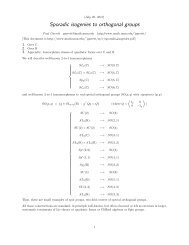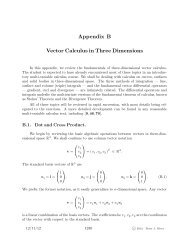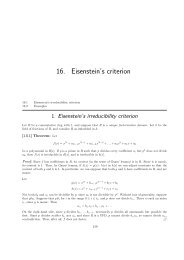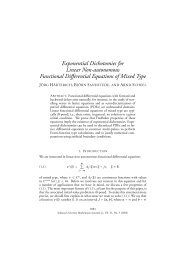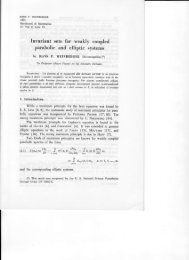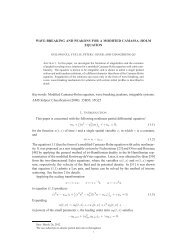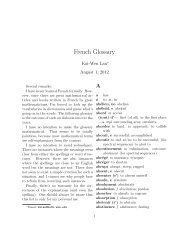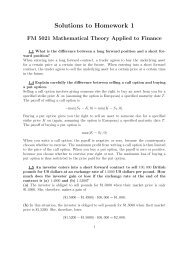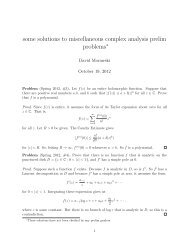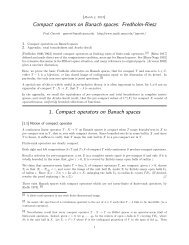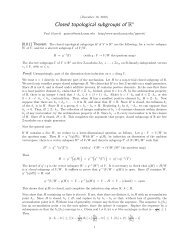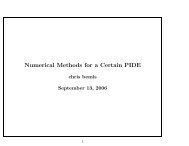Exercise (3.1). (The Grand Leap) We translate the sentence The ...
Exercise (3.1). (The Grand Leap) We translate the sentence The ...
Exercise (3.1). (The Grand Leap) We translate the sentence The ...
Create successful ePaper yourself
Turn your PDF publications into a flip-book with our unique Google optimized e-Paper software.
<strong>Exercise</strong> (<strong>3.1</strong>). (<strong>The</strong> <strong>Grand</strong> <strong>Leap</strong>)<br />
<strong>We</strong> <strong>translate</strong> <strong>the</strong> <strong>sentence</strong><br />
<strong>The</strong> grand leap of <strong>the</strong> whale up <strong>the</strong> Falls of Niagara is accounted by<br />
all who have seen it, one of <strong>the</strong> finest spectacles of Nature.<br />
into <strong>the</strong> language of L in stages, by rewriting it successively as follows:<br />
Every person who has seen <strong>the</strong> grand leap of <strong>the</strong> whale up <strong>the</strong> Falls<br />
of Niagara believes that it is one of <strong>the</strong> finest spectacles of Nature.<br />
For every person x, if x has seen <strong>the</strong> grand leap of <strong>the</strong> whale up <strong>the</strong><br />
Falls of Niagara <strong>the</strong>n x believes that this grand leap is one of <strong>the</strong> finest<br />
spectacles of Nature.<br />
Finally we get <strong>the</strong> following <strong>sentence</strong> of L. Let σ be <strong>the</strong> <strong>sentence</strong>:<br />
˙∀x (P x −→ Qx)<br />
<strong>We</strong> now see if |= A σ. <strong>The</strong> following statements are equivalent:<br />
(1)<br />
|= A σ<br />
|= A ˙∀x (P x −→ Qx)[s] (for any s)<br />
(∀a ∈ A) |= A (P x −→ Qx)[s x a]<br />
(∀a ∈ A) |= A P x[s x a] =⇒ |= A Qx[s x a]<br />
(∀a ∈ A) a ∈ P A =⇒ a ∈ Q A<br />
P A = ∅, since <strong>the</strong>re never have been whales in Niagara Falls, and so<br />
<strong>the</strong> statement a ∈ P A is false for each a. <strong>The</strong> statement<br />
a ∈ P A<br />
=⇒ a ∈ Q A<br />
is, <strong>the</strong>refore, true for each a. Hence <strong>the</strong> statement (0.1) is true, and so<br />
Benjamin Franklin was telling <strong>the</strong> truth.<br />
1
<strong>Exercise</strong> (3.2). (Sarah) <strong>The</strong> language L has a binary relation symbol<br />
G (Gxy means “x grades y”) and a constant symbol c (for Sarah). Let<br />
σ be <strong>the</strong> <strong>sentence</strong> ˙∀x (Gcx ↔ ¬Gxx). <strong>We</strong> want to determine if<br />
(2) {σ} |= Gcc ,<br />
that is, we want to know if for every structure A for L, and s,<br />
(3) |= A σ =⇒ |= A Gcc .<br />
Let A = (|A|, G A , c A ) be a structure for L. <strong>The</strong> following statements<br />
are equivalent:<br />
|= A σ<br />
|= A ˙∀x (Gcx ↔ ¬Gxx)[s] (for any s)<br />
∀a ∈ |A| |= A (Gcx ↔ ¬Gxx)[s x a]<br />
∀a ∈ |A| (c A , a) ∈ G A ⇐⇒ not (a, a) ∈ G A .<br />
But <strong>the</strong> last line is false since it implies<br />
(c A , c A ) ∈ G A ⇐⇒ not(c A , c A ) ∈ G A .<br />
Since <strong>the</strong> antecedent of (3) is false, <strong>the</strong> statement (3) is true (for every<br />
A), and hence (2) is true.<br />
<strong>Exercise</strong> (Enderton p 79 1(d)). <strong>We</strong> <strong>translate</strong> (d) successively as:<br />
Any uninteresting number with <strong>the</strong> property that all smaller numbers<br />
are interesting, certainly is interesting.<br />
For every x, ( if (x is a number and x is uninteresting and all<br />
smaller numbers are interesting) <strong>the</strong>n x is interesting).<br />
For every x, (if (x is a number and x is uninteresting and (for every<br />
y, if y is a number and y is smaller than x implies y is interesting))<br />
<strong>the</strong>n x is interesting).<br />
˙∀x (Nx ∧ ¬Ix ∧ ˙∀y (Ny ∧ y ˙
<strong>Exercise</strong> (Enderton p79 4). <strong>We</strong> <strong>translate</strong> successively:<br />
If (horses are animals) <strong>the</strong>n (heads of horses are heads of animals).<br />
If (horses are animals) <strong>the</strong>n (every head of a horse is <strong>the</strong> head of an<br />
animal).<br />
If (for every x (if x is a horse <strong>the</strong>n x is an animal)) <strong>the</strong>n (for every<br />
x (if x is <strong>the</strong> head of a horse <strong>the</strong>n x is <strong>the</strong> head of an animal))<br />
<strong>We</strong> <strong>translate</strong><br />
for every x if x is a horse <strong>the</strong>n x is an animal<br />
by ˙∀x (Ex → Ax).<br />
<strong>We</strong> <strong>translate</strong><br />
x is <strong>the</strong> head of a horse by<br />
for some y, y is a horse and x is <strong>the</strong> head of y.<br />
which becomes<br />
˙∃y(Ey ∧ x ˙=hy)<br />
and similarly for: x is <strong>the</strong> head of an animal. Finally, we get:<br />
˙∀x (Ex → Ax) −→ ˙∀x ( ˙∃y (Ey ∧ x ˙=hy) → ˙∃y(Ay ∧ x ˙=hy))<br />
<strong>Exercise</strong> (Enderton 89,10). <strong>We</strong> want to write <strong>the</strong> <strong>sentence</strong> ˙∃v 1 P v 1 ∧P v 1<br />
without abbreviations. <strong>We</strong> use <strong>the</strong> convention for abbreviations on<br />
page 78.<br />
Let α = ˙∃v 1 P v 1 (which is actually in turn an abbreviation for<br />
(¬ ˙∀v 1 (¬P v 1 )). And let β = P v 1 . <strong>The</strong>n gradually eliminating abbreviations,<br />
we get successively:<br />
(1) ˙∃v 1 P v 1 ∧ P v 1<br />
(2) α ∧ β<br />
(3) (α ∧ β)<br />
(4) (¬(α → (¬β)))<br />
(5) (¬((¬ ˙∀v 1 (¬P v 1 )) → (¬P v 1 )))<br />
(5) is in unabbreviated form.<br />
3



